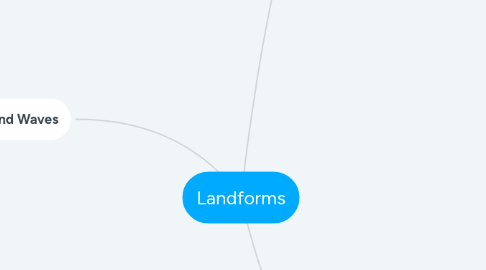
1. Ice, Wind, and Waves
1.1. Glaciers
1.1.1. Alpine Glaciers: These glaciers form wherever snow accumulates year after year without melting.
1.1.2. Continental glaciers: These glaciers cover vast areas of Greenland and Antarctica.
1.2. Impact of Past Glaciations: These glaciers shaped landforms. They created rivers of ice that melted back toward the poles or upslope to cold areas, and left behind debris that shapes the landforms we see today in many regions.
1.3. Effects of Wind on Landforms: Wind erosion also creates and effects landforms. These include deserts, farmland, and coastal areas where beaches are kept free of vegetation by waves washing the shore.
1.4. Coastal Erosion
1.4.1. Sea Level Change:
1.4.2. Human Impact on Coastal Processes
1.4.3. Waves: When winds blow across the sea surface, the energy to the water generates waves.
1.4.3.1. Tsunami: This is an extremely long wave created by an underwater earthquake. This may travel hundreds of kilometers per hour.
1.4.3.2. Beach: Waves constantly break and move sand up and down, to create beaches.
1.4.4. Longshore current: Waves move up the beach and then recede. When the waves break, their energy gives a push to the water in a direction parallel to the shore, and the repeated breaking of many waves generates a longshore current.
2. Plate Tectonics
2.1. Earth's Moving Crust
2.1.1. Earthquakes
2.1.1.1. Focus: The place where earths crusts actually moves.
2.1.1.2. Epicenter: The point on the surface directly above the focus.
2.1.2. Volcanoes: This is where the surface vent allows lava to emerge over the surface. When lava emerges it forms landforms on the Earth.
2.1.2.1. Shield Volcanoes: Each of the Hawaiian Islands is a large shield volcano . This is how the Shield Volcanoes got their name, from their shape.
2.1.2.2. Composite Cone Volcanoes: These volcanoes are explosive and cause death and destruction.
2.2. Boundaries Between Plates
2.2.1. Divergent Plate Boundaries: A boundary where plates are spreading apart. This happens at a rate of 1 inch per year.
2.2.1.1. Seafloor Spreading: Where two plates are diverging on the seafloor
2.2.2. Convergent Plate Boundaries: This is a boundary where plates are pushing together. One plate is slowly forced downward into the mantle. This is how the Rocky Mountains were formed.
2.2.3. Transform Plate Boundaries: This is a boundary where the plates neither converge nor diverge, but grind past each other.
2.3. Rock Formation
2.3.1. Types of Rocks
2.3.1.1. Igneous Rocks: These Rocks are formed when molten crustal material cools and solidifies. Some examples of these rocks are basalt, and granite.
2.3.1.2. Sedimentary Rocks:These rocks are formed when rocks eroded from higher elevations accumulate at lower elevations. When these rocks are subjected to high pressure, they bind together to create sandstone, shale, conglomerate, and limestone.
2.3.1.3. Metamorphic Rocks: These rocks are created when they are exposed to great pressure and heat, creating crystalline rocks.
2.3.2. Stress on Rocks
2.3.2.1. Faults: Happens when stress on rocks become stressed far enough, and they fracture on cracks called faults.
2.3.2.1.1. Normal Fault: When the rocks break apart because they are stretched it forms the type of fault.
2.3.2.1.2. Reverse Faults: these fractures are made when they are compressed.
2.3.2.1.3. Thrust Faults: Are made if there is a horizontal movement.
2.3.3. Rocks and Landforms
2.3.3.1. Structural Landforms: Created by variations in the resistance of rocks to exogenic processes cause weak rocks to be removed more rapidly while more resistant rocks remain in place. The shape of the land then reflects the underlying rock structures.
2.3.4. Minerals: Natural substances that comprise rocks.
2.3.4.1. Sima: Dense rocks that are dominated by compounds of silicon, magnesium, and iron minerals.
2.3.4.2. Sial: Less dense rocks that are dominated by compounds of silicon and aluminum minerals.
2.3.4.3. Shields: Vast areas of continental crust.
3. Slopes and Streams
3.1. Weathering
3.1.1. Chemical Weathering: The change in the elements that compose rocks when they are exposed to air and water.
3.1.2. Mechanical Weathering: When rocks are broken down by a physical force.
3.2. Moving Weathering Material
3.2.1. Mass Movement
3.2.1.1. Soil creep: This is a very slow, gradual movement of material down the slope of a hill.
3.2.2. Surface Erosion
3.2.3. Increased Erosion From Human Activity

